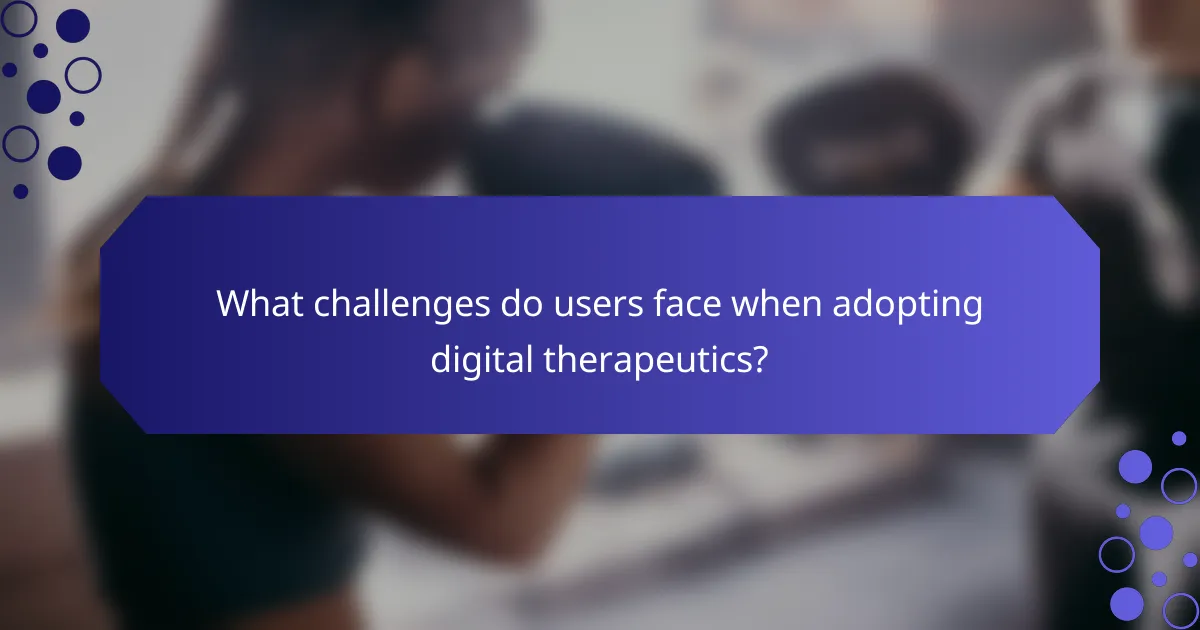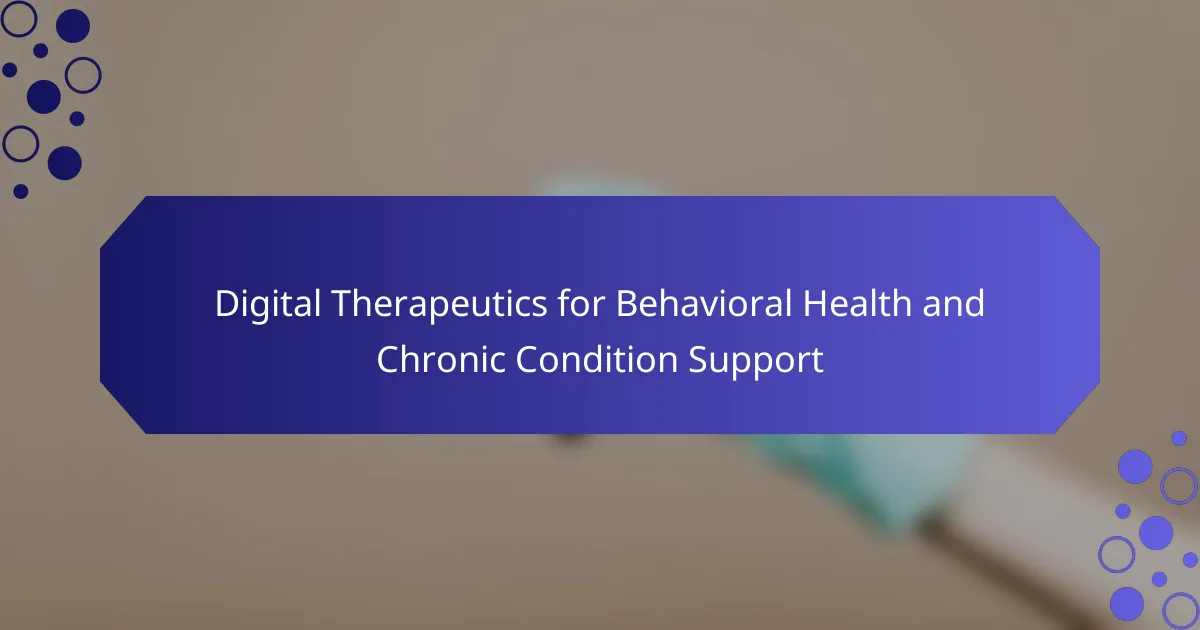Digital therapeutics offer significant benefits for managing behavioral health and chronic conditions by providing personalized interventions and continuous monitoring. They enhance treatment adherence and facilitate real-time data integration. However, challenges such as technology access and user engagement must be addressed. Future trends focus on AI-driven personalization and wearable technology integration to improve outcomes.

How do digital therapeutics improve behavioral health outcomes?
Digital therapeutics enhance behavioral health outcomes by providing personalized interventions and continuous monitoring. They utilize data-driven approaches to support individuals in managing conditions like depression and anxiety. Studies indicate that these digital solutions can lead to significant reductions in symptoms and improved overall well-being. For instance, a meta-analysis found that users experienced a 30% decrease in depressive symptoms after engaging with digital therapy programs. Additionally, these tools facilitate greater accessibility to care, enabling timely interventions and fostering engagement in treatment.
What evidence supports the efficacy of digital therapeutics in mental health?
Digital therapeutics have shown significant efficacy in improving mental health outcomes. Clinical studies demonstrate that these digital interventions can reduce symptoms of anxiety and depression, enhance coping strategies, and improve overall well-being. For instance, a meta-analysis revealed that users of digital therapeutics experienced a 50% reduction in depressive symptoms compared to control groups. These tools often leverage cognitive-behavioral therapy principles, providing personalized support and accessibility. Furthermore, they are particularly beneficial for individuals with chronic conditions, offering integrated mental health support alongside physical health management.
Which behavioral health conditions benefit most from digital therapeutics?
Digital therapeutics significantly benefit various behavioral health conditions, particularly anxiety disorders, depression, substance use disorders, and chronic stress. These conditions often exhibit symptoms that digital interventions can effectively address through personalized programs and real-time feedback. For instance, studies show that digital therapeutics can lead to a 30% improvement in anxiety symptoms and a 25% reduction in depression levels. Additionally, they offer unique attributes such as accessibility and scalability, making them suitable for a broader range of individuals.
How do user engagement levels affect therapeutic outcomes?
User engagement levels significantly influence therapeutic outcomes in digital therapeutics for behavioral health and chronic condition support. Higher engagement correlates with improved adherence to treatment protocols and better health results. Engaged users often report greater satisfaction and motivation, leading to sustained behavioral changes. Studies indicate that consistent interaction with therapeutic platforms enhances the effectiveness of interventions.
What role does personalization play in digital therapeutic solutions?
Personalization is crucial in digital therapeutic solutions as it enhances user engagement and treatment effectiveness. Tailored interventions address individual needs, preferences, and behaviors, leading to improved adherence and outcomes. For instance, personalized feedback can motivate users, while adaptive content adjusts to progress over time. This customization fosters a sense of ownership and relevance, making therapies more impactful. Overall, personalization transforms digital therapeutics into more effective tools for managing behavioral health and chronic conditions.

What are the primary features of digital therapeutics for chronic conditions?
Digital therapeutics for chronic conditions offer personalized treatment, real-time monitoring, and evidence-based interventions. Key features include accessibility via mobile devices, integration with health data, and support for patient engagement. These tools enhance adherence to treatment plans and provide tailored feedback, improving health outcomes. They often utilize cognitive behavioral therapy techniques and can be adjusted based on individual progress, making them adaptable to unique patient needs.
Which technologies are commonly used in digital therapeutics?
Digital therapeutics commonly utilize mobile applications, wearable devices, telehealth platforms, and artificial intelligence. These technologies enhance patient engagement, provide real-time monitoring, and facilitate personalized treatment plans. Mobile apps offer accessibility and convenience, while wearables track health metrics. Telehealth platforms improve access to care, and AI analyzes data for tailored interventions.
How do mobile applications enhance chronic condition management?
Mobile applications significantly enhance chronic condition management by providing personalized support and real-time monitoring. They enable users to track symptoms, medication adherence, and lifestyle changes effectively.
Digital therapeutics leverage data analytics to deliver tailored interventions, improving patient engagement. For instance, reminders for medication can increase adherence rates by up to 50%. These applications also facilitate communication with healthcare providers, allowing for timely adjustments to treatment plans.
Moreover, mobile apps often incorporate educational resources, empowering users with knowledge about their conditions. This access to information fosters self-management skills, leading to better health outcomes.
Finally, some applications utilize gamification techniques to motivate users, making the management of chronic conditions more engaging and less burdensome.
What are the key metrics for measuring success in digital therapeutic interventions?
Key metrics for measuring success in digital therapeutic interventions include patient engagement, clinical outcomes, adherence rates, and cost-effectiveness. These metrics provide insights into the effectiveness and impact of interventions on behavioral health and chronic conditions.
Engagement metrics assess user interaction frequency and duration. Clinical outcomes measure improvements in health indicators, such as symptom reduction or quality of life. Adherence rates evaluate the consistency of patient usage over time. Cost-effectiveness compares intervention costs to healthcare savings, highlighting overall value.
Tracking these metrics enables continuous improvement and validation of digital therapeutic solutions.

What challenges do users face when adopting digital therapeutics?
Users face several challenges when adopting digital therapeutics for behavioral health and chronic condition support. Key issues include technology access, user engagement, and integration with existing healthcare systems.
Access to technology can be limited by socioeconomic factors, creating disparities in usage. User engagement often suffers due to a lack of motivation or understanding of the therapeutic benefits. Integration with healthcare systems can be complex, leading to fragmented care and data sharing issues.
Furthermore, privacy concerns may deter users from fully embracing digital solutions. These challenges highlight the need for tailored approaches to enhance adoption and effectiveness in digital therapeutics.
How does user accessibility impact the effectiveness of digital therapeutics?
User accessibility significantly enhances the effectiveness of digital therapeutics by ensuring all individuals can engage with the technology. Accessible designs cater to diverse needs, improving user experience and adherence to treatment protocols. Studies show that when digital therapeutics are user-friendly, engagement rates increase by up to 70%. This accessibility includes features like voice commands, screen readers, and customizable interfaces, which address unique user requirements. By focusing on these aspects, digital therapeutics can better support behavioral health and chronic conditions, ultimately leading to improved health outcomes.
What privacy concerns are associated with digital therapeutic platforms?
Digital therapeutic platforms face significant privacy concerns due to sensitive health data handling. Users worry about data breaches, unauthorized access, and misuse of personal information. Compliance with regulations like HIPAA is crucial to ensure data protection. Additionally, transparency about data usage and sharing practices is essential to build user trust.
Which demographic factors influence the adoption of digital therapeutics?
Demographic factors significantly influence the adoption of digital therapeutics. Age, income, education level, and health literacy are key determinants that affect user engagement and success rates.
Younger individuals tend to adopt these technologies more readily due to familiarity with digital tools. Higher income levels correlate with greater access to devices and internet connectivity, facilitating usage. Education level impacts understanding and willingness to engage with complex digital solutions. Health literacy is crucial; those with higher literacy are more likely to utilize digital therapeutics effectively.
As a result, tailoring digital therapeutic solutions to address these demographic variations can enhance adoption and improve health outcomes.

How do digital therapeutics integrate with traditional healthcare systems?
Digital therapeutics integrate with traditional healthcare systems by enhancing patient engagement and providing data-driven insights. These technologies enable real-time monitoring and support for behavioral health and chronic conditions, improving treatment outcomes. They complement existing care by offering personalized interventions and tracking patient progress. As a result, healthcare providers can make informed decisions based on comprehensive data from digital platforms, leading to more effective management of conditions.
What are the best practices for healthcare providers implementing digital solutions?
Healthcare providers should follow best practices to effectively implement digital solutions for behavioral health and chronic condition support. Prioritize user-centered design to enhance engagement and adherence. Ensure compliance with regulatory standards to protect patient data and maintain trust.
Integrate digital therapeutics with existing workflows to streamline processes and improve care coordination. Provide comprehensive training for staff to maximize the utilization of digital tools. Continuously collect and analyze data to assess effectiveness and make necessary adjustments.
Regularly update digital solutions to incorporate the latest evidence-based practices and technology advancements. Foster collaboration among multidisciplinary teams to enhance the overall patient experience and outcomes.
How do reimbursement policies affect the adoption of digital therapeutics?
Reimbursement policies significantly influence the adoption of digital therapeutics by determining financial viability for providers and patients. Favorable reimbursement can enhance accessibility, encouraging healthcare providers to integrate these solutions into treatment plans. Conversely, restrictive policies may hinder adoption, limiting patient access and reducing the incentive for providers. Studies show that when insurance covers digital therapeutics, usage rates increase, leading to better health outcomes for chronic conditions and behavioral health issues.

What unique attributes distinguish leading digital therapeutic platforms?
Leading digital therapeutic platforms are distinguished by their unique attributes, including personalized treatment plans, real-time data analytics, and user engagement features. These platforms often utilize advanced algorithms to tailor interventions based on individual needs. Additionally, integration with wearable technology enhances monitoring and feedback, promoting adherence to treatment protocols. A focus on evidence-based practices ensures efficacy, while regulatory compliance fosters trust among users.
Which companies are pioneers in the digital therapeutics space?
Companies leading the digital therapeutics space include Omada Health, Pear Therapeutics, and WellDoc. These pioneers focus on behavioral health and chronic condition support, leveraging technology to deliver evidence-based interventions. Omada Health specializes in diabetes prevention, Pear Therapeutics offers prescription digital therapeutics for substance use disorders, and WellDoc provides solutions for managing diabetes. Their innovative approaches enhance patient engagement and improve health outcomes.
How do user reviews and feedback shape the development of digital therapeutics?
User reviews and feedback significantly influence the development of digital therapeutics by guiding design and functionality. Developers analyze user experiences to identify needs and improve efficacy, ensuring products align with real-world applications. Feedback can highlight unique attributes, such as personalization features, enhancing user engagement. Additionally, integrating user suggestions fosters trust and satisfaction, ultimately leading to better health outcomes.

What are the future trends in digital therapeutics for behavioral health?
Future trends in digital therapeutics for behavioral health focus on personalized interventions, integration with wearable technology, and enhanced data analytics. These advancements aim to improve user engagement and treatment outcomes. Personalized approaches leverage artificial intelligence to tailor therapies to individual needs. Integration with wearables allows real-time monitoring of mental health metrics, enhancing intervention efficacy. Enhanced data analytics enables providers to assess treatment effectiveness and make informed adjustments. As a result, digital therapeutics will likely become more adaptive and responsive to patient behaviors and preferences.
How is artificial intelligence transforming digital therapeutic solutions?
Artificial intelligence is revolutionizing digital therapeutic solutions by enhancing personalization, engagement, and data analysis. AI algorithms analyze patient data to tailor interventions, improving adherence and outcomes. For instance, machine learning models predict mental health crises, allowing timely interventions. Additionally, AI facilitates continuous monitoring, offering real-time feedback to users, which fosters sustained behavioral change. As a result, these advancements lead to more effective management of chronic conditions and behavioral health challenges.
What emerging technologies are expected to enhance digital therapeutics?
Emerging technologies enhancing digital therapeutics include artificial intelligence, wearables, and virtual reality. These innovations improve patient engagement, personalize treatment, and offer real-time monitoring.
Artificial intelligence algorithms analyze patient data, predicting outcomes and tailoring interventions. Wearable devices track vital signs and behaviors, fostering adherence to treatment plans. Virtual reality provides immersive therapy experiences, particularly beneficial for anxiety and PTSD.
As a result, these technologies create a more effective and responsive approach to managing behavioral health and chronic conditions.
Which regulatory changes could impact the digital therapeutics landscape?
Regulatory changes, such as increased FDA scrutiny and new reimbursement models, could significantly impact digital therapeutics for behavioral health and chronic condition support. These changes may enhance safety and efficacy standards, ensuring better patient outcomes. Additionally, evolving privacy regulations could influence data usage and patient engagement strategies. As a result, companies must adapt to remain compliant and competitive in this dynamic landscape.
What are the best practices for maximizing the effectiveness of digital therapeutics?
To maximize the effectiveness of digital therapeutics, focus on user engagement, personalization, and evidence-based content. Ensure that the therapeutic programs are tailored to individual needs, which enhances adherence and outcomes. Regularly update content based on user feedback and clinical guidelines to maintain relevance and effectiveness. Incorporate data analytics to track progress and adjust interventions accordingly, fostering a supportive environment for behavioral health and chronic condition management.
